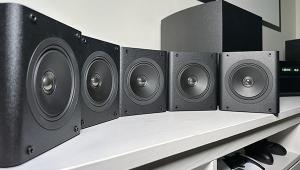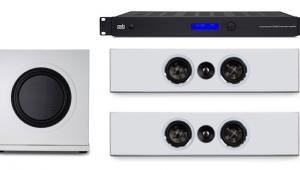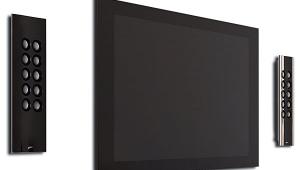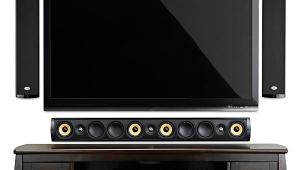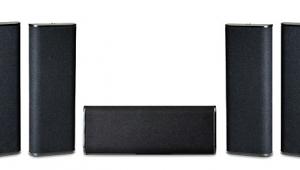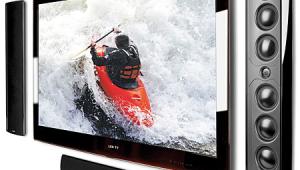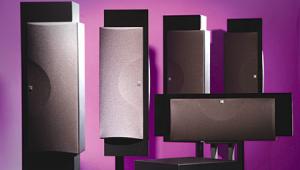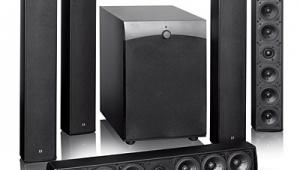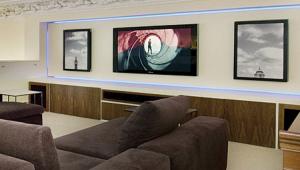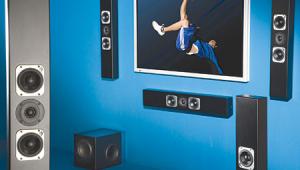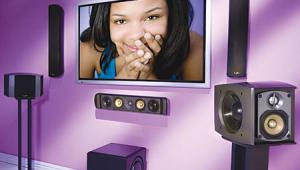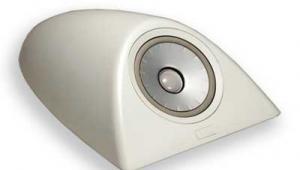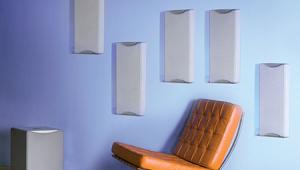Piega AP-3 Speaker System and Arcam Solo Movie 5.1 System
The big trend is smallness. Flat is the new phat. Manufacturers who want space in your home compete most effectively by taking up less of it. And, in case you hadn't heard, less is more.
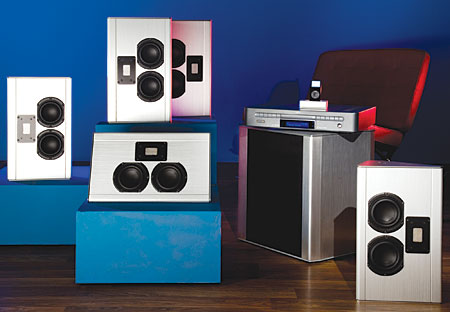
Flat-panel TVs and microdisplay front and rear projectors have all but annihilated tube-based direct-view and rear-projection sets. Will some cartoon superhero leap off the pages of comic books (excuse me, graphic novels) to save the lowly inhabitants of black-box land—the loudspeaker and the receiver? Or will they simply morph into different shapes and become the heroes of their own story?
Piega's AP-3 speakers would look good in tights and a cape. The speakers are triangular solids designed to don brackets and leap up the wall, Spiderman-like. Mate them with the Arcam Solo Movie 5.1 (a DVD receiver with the slim dimensions of a standard DVD player), and you've got a new dynamic duo set to take on the world.
Tough Cookies
The Piega AP-3 is part speaker, part fortress. Clad in extruded aluminum and weighing more than 13 pounds, it's extremely solid and heavy. Perforated steel grilles come in your choice of black, white, or gray with a thin layer of fabric on the inside. Their metal tabs snap into a narrow channel in the baffle.
Piega's ace in the hole is their ribbon tweeter. The rectangular strip of aluminum is only 7 micro-meters (or microns) thick, or 0.000275591 of an inch. I'll let the literature describe the rest:
"The flat coil produced in a sophisticated spray-etching process was designed with an asymmetrical layout. This takes into account any nonlinearities in the magnetic field and the thermodynamic characteristics in the foil layout. The membrane foil is mounted in a glass-fiber-reinforced epoxy carrier that is positioned in a subchassis made from rubber elements with high damping properties."
Compelled into motion by a neodymium magnet, the driver is active from 3.5 kilohertz and up. Piega says it has a clean decay and low resonance. Supporting the tweeter are two 4-inch carbon-fiber-reinforced paper cone woofers. The AP-3 has little bass of its own, but the P SUB 1 MKII subwoofer can support a relatively high crossover of 120 hertz with proper placement.
The Arcam Solo Movie 5.1 is a sleek beast. It's only about half the height of an average receiver but actually weighs a little more than a low-end model. Although its power rating is modest, at 50 watts times five, it ran the Piegas just fine. The amplifiers are Class AB, which potentially uses more power than the Class D amps often found in similar-sized components, but it also has a warmer sound than most.
On either side of the DVD drawer are a half-dozen buttons. Transport and volume keys are at right, while source select and other necessities are on the left. You can set the intensity of the blue fluorescent display in any of five steps ranging from off to readable in direct sunlight.
The menu sports above-average graphics and includes a few niceties worth noting. Output resolutions include 1080i, 720p, 480p, and 480i. There is no 1080p, but there is, to my joy, a 768p setting that I chose for my 32-inch Sharp LCD HDTV. You can set the black level to 0 or 7.5 IRE. Audio settings for delays and trims (levels) are bar graphs, which are kind of cool and a bit easier to read and adjust than the fluttering numerals on most receivers' displays.
The Solo Movie 5.1 is right up to date in iPod-correctness, thanks to an add-on dock that sells for $285. Heavy and well made—it's the first pleasantly overbuilt iPod dock I've seen—it connects to the unit through a multi-pin cable and jack that superficially resembles an S-video connector.
Grilles Off
I tried the Piegas with their grilles both on and off and quickly developed a preference. They sounded better to me with the grilles off (and the ribbon tweeters exposed). Voices and treble-rich instruments like violins were not only clearer but closer. With the grilles on, singers seemed to be located slightly behind the front speakers. With the grilles off, it was as though they had stepped forward exactly 1 foot, just in front of the speakers.
The treble was detailed and revealing but also sweet, refined, and transparent. The midrange was up front but smooth (grilles off) or a bit reticent (grilles on). Bass was taut and satisfying. A string bass became audible as a three-step process—the attack, the swelling of the note in the instrument's body, and the decay—each step with distinct and separate timing. There was no obvious overhang.
"Theresa's Sound-world" from the Sonic Youth CD Dirty has been one of my favorite test tracks for years. This time, a huge, aggressive drum sound leaped out of the sub, swathed in clouds of cymbals. The sub and speakers conspired to deliver Kim Gordon's monster fuzz-bass riff on "Youth Against Fascism." The miked-amplifier recording method benefited the busy guitarists, making the studio's ambience palpable in another great Butch Vig production.
The second volume of Brahms: Five Trios by Golub, Kaplan, and Carr on Arabesque has always been my favorite recording of these amazing piano trios. The opening movement of the Trio in C Minor showed off a decent string sound (for a 1989 digital recording). There was also a good balance between the pianist's left and right hands, with no obvious "oh, that must be the sub" moments. But what pleased me most was the low-level resolution of the subdued second movement. A lot of speakers can declaim, but very few are effective at a whisper.
 Solo violin is a stern test of any speaker, especially the tweeter. I took advantage of the Arcam's SACD capability and turned to Julia Fischer's superlative reading of Bach's Sonatas and Partitas for Solo Violin. Telarc's equally superlative 5.1-channel recording makes full use of the center channel. The system passed this ultimate test of transparency, not merely sketching an outline of the instrument's tone, but painting it in full color. Low-level moments were easily intelligible. And when the violin played at the top end of its volume range, it did not become strident or in any way unlistenable.
Solo violin is a stern test of any speaker, especially the tweeter. I took advantage of the Arcam's SACD capability and turned to Julia Fischer's superlative reading of Bach's Sonatas and Partitas for Solo Violin. Telarc's equally superlative 5.1-channel recording makes full use of the center channel. The system passed this ultimate test of transparency, not merely sketching an outline of the instrument's tone, but painting it in full color. Low-level moments were easily intelligible. And when the violin played at the top end of its volume range, it did not become strident or in any way unlistenable.
Doom and Strings
Although the AP-3 has a rated sensitivity of 90 decibels, it liked power. To maintain a normal dialogue level with my Rotel RSX-1065 reference A/V receiver, I had to use a volume setting of 55, versus an average of 50 or less with most of my review speakers.
I briefly compared the Arcam to my reference receiver and found it to be warmer (and the Rotel is warm to begin with). It was also spatially a bit flatter. It betrayed no sign of serious strain and didn't run especially hot.
With movies, the Piega subwoofer thrived. The metal-clad monster did more than predictably bulk up explosions. It also enriched minor bass-related moments. For instance, The Good Shepherd is shot through with small, low synth pulses that indicate ill-omened turns in the story line. This is about as common as movie sound effects ever get. But the P SUB 1 MKII (decidedly not-so-sexy model number notwithstanding) made each one genuinely unsettling.
The Libertine tells its story of a decadent nobleman with a deliberate visual and aural contrast between elegance and squalor. What endows the soundtrack with its elegant side is a string ensemble that punches through the often astonishingly grimy images with a sweet, satin-finished texture that less subtle tweeters would surely have distorted or buried. A low-voiced speech by John Malkovich was the only vocal element that slithered noticeably from the center into the subwoofer during my review period.
An initial reserve is what brings First Born a cut above the average horror movie. For the first half-hour, the surround effects are thin on the ground (that is to say, there aren't many). But as the story ramps up in suspense, activity increases in the surround channels, and they wax eloquently past the one-hour mark. I especially loved a storm heard inside the spooky suburban house, the sound of rolling thunder voluptuously wandering around the soundfield.
The Piega AP-3 is an achiever in the characteristically underachieving genre of on-wall speakers. It delivers a musically and cinematically whole listening experience, succeeding where so many of its peers fail. Combined with the Arcam Solo Movie 5.1, it will unbulk your home theater system and still provide satisfying results.
Highlights
Piega AP-3 Speaker System:
• Ribbon tweeter for extended high frequencies
• Durable aluminum enclosures
• Among few listenable on-walls
Highlights
Arcam Solo Movie 5.1 System:
• Combo DVD-receiver cuts system bulk
• Includes SACD and DVD-Audio drive
• Warm British sound
- Log in or register to post comments
